Your ideal root cellar temperature should stay between 32-40°F (0-4.4°C) with 85-95% humidity for ideal produce storage. You'll need to maintain different temperature zones – cooler areas for root vegetables, middle zones for cucumbers and tomatoes, and warmer spots for winter squash and sweet potatoes. Use min/max thermometers and humidity sensors to monitor conditions, and implement proper ventilation with inlet and outlet vents for air circulation. Natural cooling methods like earth tubes and passive heat exchange can help regulate temperatures without electricity. The right combination of temperature control and humidity management will reveal months of successful underground storage.
Understanding Root Cellar Temperature Basics
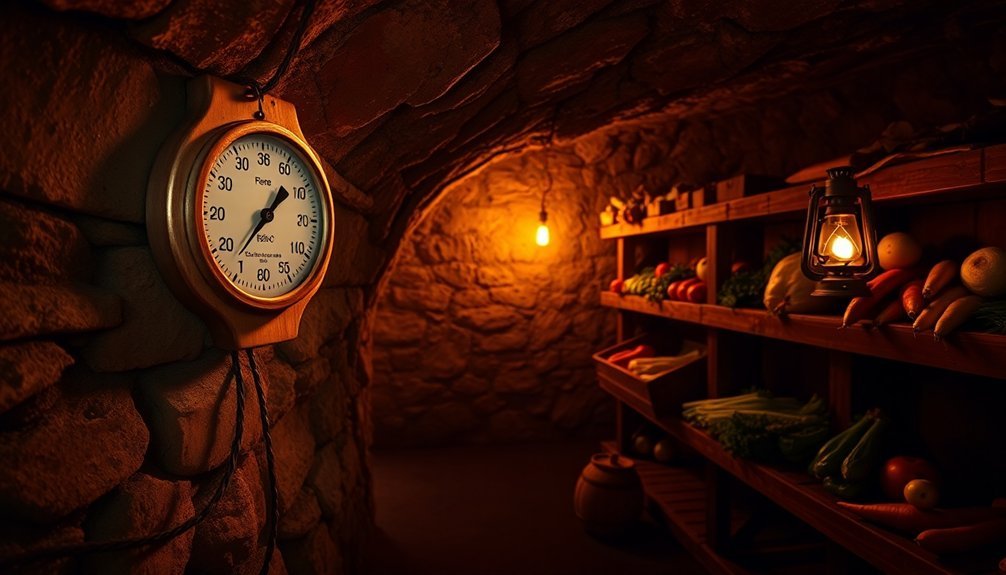
Root cellar success hinges on maintaining the right temperature range of 32 to 40°F (0 to 4.4°C). This ideal range prevents your produce from freezing while greatly reducing spoilage rates.
You'll need to pay special attention to areas near vents and exterior doors, where temperatures can unexpectedly drop below freezing and damage your stored goods. Using wood shelving units helps maintain stable temperatures while providing antibacterial benefits.
Understanding how temperature varies within your root cellar is vital for effective storage. You'll find that warm air naturally rises, creating different temperature zones from floor to ceiling.
This variation actually works to your advantage, as you can store different crops according to their specific temperature needs. Root vegetables will thrive in the cooler areas near the floor, while other produce might do better in slightly warmer spots.
To maintain perfect conditions, you'll want to monitor your cellar's temperature using min/max thermometers. The earth's natural insulation helps keep temperatures stable, but factors like latitude, underground water, and local soil conditions will affect your cellar's temperature.
You can check hydrology maps to better understand your area's soil temperatures and plan accordingly. Remember that proper ventilation is essential for controlling both temperature and humidity levels.
Best Temperature Ranges By Season
Throughout the year, your root cellar's temperature requirements will shift with the changing seasons. You'll need to maintain specific ranges to keep your produce fresh and prevent spoilage.
| Season | Ideal Temperature Range & Requirements |
|---|---|
| Winter | 32-40°F (0-4°C), maintain 85-95% humidity for root vegetables |
| Spring | Gradually increase temp, manage ventilation to prevent sudden changes |
| Summer | Keep warm air out, focus on heat-tolerant produce like garlic and onions |
| Fall | Return to cooler temps, prep for winter storage with proper insulation |
| Year-Round | Use ventilation and monitoring to maintain consistent conditions |
During winter, you'll want to store root vegetables in perforated containers filled with sand or sawdust. As spring approaches, gradually adjust ventilation to prevent temperature shock. Summer presents the biggest challenge – you'll need to focus on keeping warm air out while maintaining proper air circulation with fans or natural ventilation. In fall, prepare your cellar for the upcoming storage season by sealing gaps and organizing storage areas. You can improve temperature control by choosing north-facing slopes or underground locations for your root cellar, ensuring ideal conditions year-round. Using a dirt floor basement provides natural moisture regulation and helps maintain optimal humidity levels for vegetable storage.
Monitoring Tools and Equipment
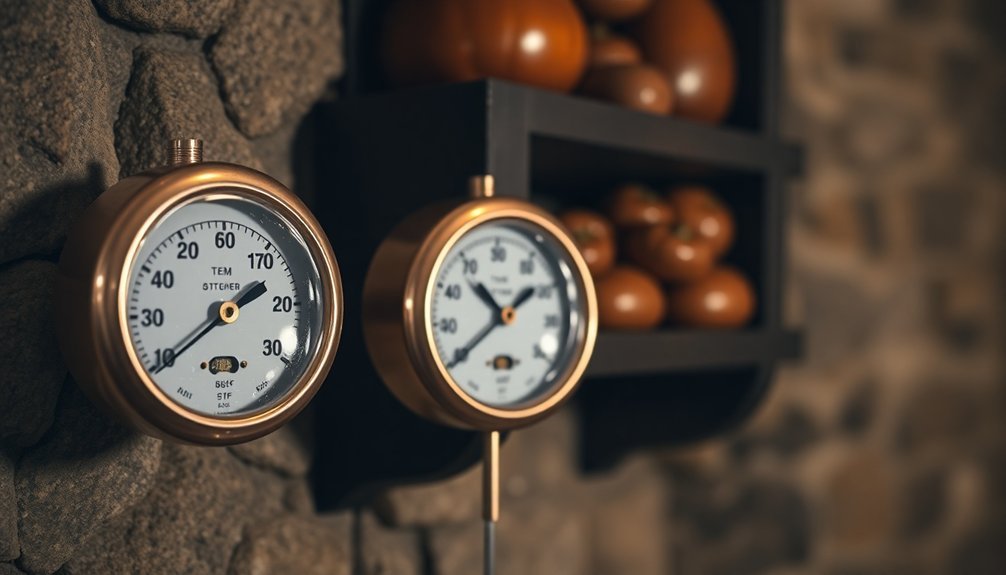
Successfully maintaining your root cellar's temperature relies on proper monitoring equipment. You'll need temperature and humidity sensors that can accurately measure your storage conditions and provide real-time data access.
These devices can transmit information directly to your mobile phone or local network, allowing you to track conditions even when you're away from your cellar. The operating temperature range extends from -20°C to +70°C, ensuring reliable monitoring in various conditions.
To get the most accurate readings, you'll want to place your sensors strategically throughout the space. Mount them on walls or shelves in different areas to monitor various zones within your cellar.
Consider using protective cases to shield your devices from moisture and environmental factors, and make certain your cabling is properly routed to prevent damage.
Many modern monitoring systems offer additional features that'll help you maintain ideal conditions. You can connect multiple sensors to a single gateway and set up alerts when temperatures or humidity levels exceed your specified thresholds.
Some systems even integrate with smart home devices, allowing you to control fans or misters automatically. Keep in mind that you'll need reliable internet access for many of these advanced monitoring features to work properly.
Natural Cooling Methods
Natural cooling methods offer efficient, low-cost solutions for maintaining your root cellar's ideal temperature. You'll find that earth cooling provides a stable foundation, as the ground below frost level maintains a consistent 52°F year-round. By digging your cellar into the earth, you're effectively borrowing this natural cooling power.
| Method | How It Works | Benefits |
|---|---|---|
| Passive Heat Exchange | Butane-filled copper pipes transfer heat when temps are below 31°F | No electricity needed |
| Earth Cooling | Uses ground's natural 52°F temperature | Stable year-round cooling |
| Ventilation | Two-vent system moves warm air out, cool air in | Natural air circulation |
| Ice Storage | Store winter ice for summer cooling | Supplemental cooling |
You can enhance these natural methods by implementing a passive heat exchange system using butane-filled copper pipes. This system works automatically when outside temperatures drop below 31°F, requiring no electricity. Set up proper ventilation with two vents – one low and one high on opposite walls – to create natural air circulation. For additional cooling, store ice during winter months or consider using groundwater through a heat exchanger, which typically stays between 50-55°F.
Crop Storage Temperature Requirements
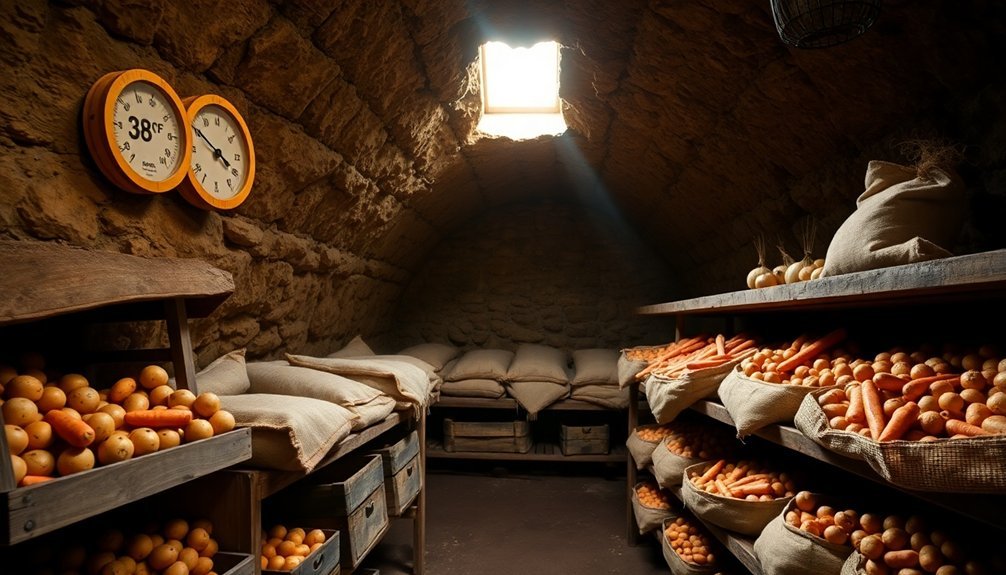
Once you've established proper cooling methods in your root cellar, you'll need to organize your crops based on their specific temperature requirements.
Most cool-season vegetables like carrots, beets, broccoli, and cabbage thrive at 32°F with high humidity levels between 95-100%. You'll want to store these together in the coolest section of your cellar.
Warm-season crops require slightly higher temperatures. Store your sweet potatoes at 55-60°F, while peppers and okra need 45-55°F. Pumpkins and winter squash prefer temperatures around 50-55°F with lower humidity levels. You'll need to keep these vegetables in a separate, slightly warmer area.
Root vegetables generally need cool conditions around 32-40°F. Potatoes are an exception, preferring 40°F with 90-95% humidity. Store onions separately, as they need lower humidity (65-70%) to prevent rotting.
For fruits, maintain temperatures between 29-32°F. Apples and pears require 90-95% humidity, while grapes need slightly less at 85%.
Remember to keep ethylene-producing fruits like apples separate from other crops, as they can cause premature ripening and spoilage of nearby vegetables.
Humidity Control Techniques
You'll find that natural sources like dirt floors and damp burlap bags provide essential moisture for root cellar storage.
To manage moisture levels effectively, pack your vegetables in materials like damp sawdust or sand while using water-filled trays to maintain 90-95% humidity.
Balance your ventilation system by adjusting air intake vents and ensuring proper circulation between storage containers to prevent both excessive moisture and unwanted dry conditions.
Natural Humidity Sources
Controlling humidity in your root cellar starts with leveraging natural moisture sources. You'll find that dirt floors are your best natural ally, as they retain moisture better than concrete or stone surfaces. When combined with gravel, they'll keep your storage area dry while maintaining ideal humidity levels.
| Material | Benefit | Best Use |
|---|---|---|
| Dirt Floor | Natural moisture retention | Base flooring |
| Gravel | Drainage + humidity balance | Top layer over dirt |
| Damp Sawdust | Surface moisture control | Root vegetable packing |
| Moist Sand | Consistent humidity | Long-term storage |
| Wet Moss | High moisture retention | Delicate produce |
You'll get the most effective humidity control by keeping your cellar at full capacity, as the vegetables themselves contribute moisture to the environment. Pack root vegetables like carrots, beets, and parsnips in damp sawdust or sand to reduce surface evaporation and keep them firm. If you need additional moisture, try spreading damp burlap bags over your produce or placing water pans on the floor. Underground cellars naturally maintain higher humidity levels thanks to earth's moisture, but proper insulation is essential for retaining this beneficial environment.
Managing Moisture Levels
While natural moisture sources provide a foundation for root cellar humidity, active management guarantees perfect conditions year-round. You'll need to maintain humidity levels between 85-95% to prevent your vegetables from drying out and losing their freshness. This is especially vital for root crops and leafy vegetables that depend on consistent moisture to stay crisp.
To boost humidity in your root cellar, you can implement several effective techniques. Place containers of water on the floor to create natural evaporation, or sprinkle water directly on gravel surfaces. You'll find that damp burlap bags over produce and packing vegetables in moist sawdust or sand helps retain surface moisture.
- Water droplets forming on the ceiling of your root cellar, creating a gentle mist that settles on stored vegetables
- Moistened wood shavings releasing steady humidity into the air, surrounding your produce with protective moisture
- Damp burlap bags draped over vegetable crates, their fibers slowly releasing moisture into the storage space
Monitor humidity levels regularly with a hygrometer and adjust your moisture-adding methods accordingly. If levels become too high, increase ventilation to prevent condensation and potential spoilage.
Remember to remove any affected produce promptly to maintain ideal storage conditions.
Ventilation Balance Methods
A well-balanced ventilation system serves as the foundation of effective root cellar humidity control.
You'll need to install both inlet and outlet vents to create proper air circulation that manages temperature and humidity. Place your inlet vent near the floor where cool air enters, and position the outlet vent high up, preferably near the ceiling, to let warm air escape naturally.
To maintain ideal conditions, you'll want to adjust your vents seasonally. During summer, keep vents open to promote air circulation and prevent excess humidity buildup. In winter, you can close them partially to maintain the perfect 32-40°F temperature range.
Monitor your root cellar's conditions using a thermometer and hygrometer, making vent adjustments as needed. If you're noticing stagnant air or excess moisture, consider using a small fan to enhance circulation.
Remember to check your vents regularly for blockages and verify they're sealing properly when closed. The key is to create a consistent flow that removes ethylene gases and unwanted odors while maintaining the 85-95% humidity level that's essential for proper food storage.
Underground Temperature Regulation Systems
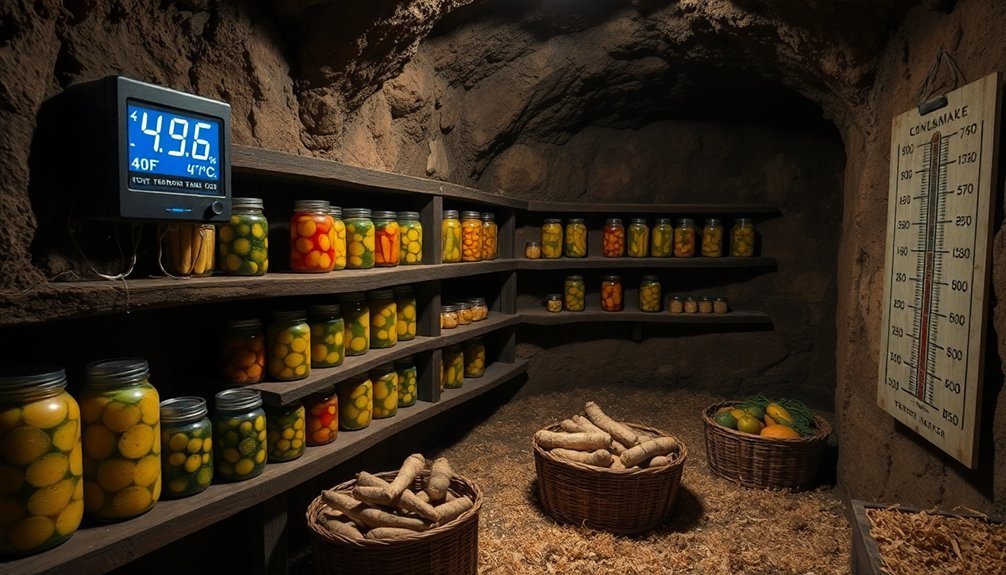
Your root cellar's temperature control depends on three essential systems working together: natural ground cooling, ventilation control, and proper insulation layers.
You'll need to position your ventilation system to take advantage of cool night air while preventing warm daytime air from entering the cellar.
The earth's natural insulation, combined with strategically placed layers of additional insulating materials, will help you maintain the ideal 32-40°F range throughout the year.
Natural Ground Cooling Methods
Natural cooling methods deep within the ground have proven remarkably effective for root cellar temperature control. You'll find that at just 4 feet underground, temperatures remain surprisingly stable throughout the year. This natural phenomenon makes it possible to maintain ideal storage conditions around 40°F, though you'll need to reflect on your specific latitude and local groundwater conditions.
You can enhance your root cellar's natural cooling capacity by incorporating passive heat exchange systems or earth tubes. These time-tested methods don't require electricity and work by utilizing the earth's consistent underground temperature.
When you're planning your root cellar, contemplate these proven cooling approaches:
- Underground pipes filled with butane that naturally cycle between liquid and gas states, pulling heat away from your storage area
- Earth tubes that draw in outside air and naturally condition it by passing through underground channels
- Ground-coupled ventilation systems that work like nature's own air conditioning
Be mindful of your local water table and soil conditions, as they'll greatly impact your cellar's performance. In areas with high water tables or shallow soil, you might need to modify your design or contemplate alternative storage solutions.
Ventilation Control Systems
Building on the principles of ground cooling, effective ventilation control systems take root cellar temperature management to the next level. You'll find several reliable options, from simple PVC-based systems to sophisticated ground-source heat pumps.
| System Type | Key Features |
|---|---|
| PVC Ventilation | • Uses durable Schedule 40 PVC tubing • Natural flow of cold/hot air • Pluggable vents for extreme weather |
| Fan-Controlled | • ESP8266 microcontroller integration • Smart humidity management • Real-time monitoring capabilities |
| Earth Tubes | • 2-meter deep underground pipes • Passive temperature regulation • Minimal energy requirements |
| Ground Source Heat Pumps | • Closed-loop piping systems • Year-round temperature control • 40-90°F operating range |
You can implement these systems individually or in combination for ideal results. For basic needs, start with a PVC system using two tubes – one near the floor for cold air intake and another near the ceiling for hot air exhaust. If you're tech-savvy, consider adding fan controls with humidity management. For long-term efficiency, earth tubes or ground source heat pumps offer reliable temperature regulation with minimal energy costs, though they require more initial investment.
Insulation Layer Distribution
The strategic distribution of insulation layers forms the backbone of an effective underground root cellar system. You'll want to work with nature by letting the earth's natural insulating properties do most of the work, maintaining a steady 52°F (11.1°C) at proper depth.
Don't insulate the soil-facing exterior walls, as they're essential for heat transfer from the surrounding earth.
Focus your insulation efforts on the roof and ceiling, where heat gain is most likely to occur. You can create multiple protective barriers by layering different materials strategically. An anteroom design adds an extra buffer zone, helping you maintain distinct temperature zones while protecting your main storage area from temperature fluctuations when accessing the cellar.
- Picture a hillside cellar with thick earthen walls, topped by a living roof where grass and wildflowers wave in the breeze
- Envision a well-planned anteroom with sturdy wooden doors, creating an airlock effect between the outside world and your stored produce
- Imagine layers of straw and rigid foam insulation beneath the soil-covered roof, invisible but working constantly to maintain ideal temperatures
These combined insulation strategies work together to create a naturally regulated storage environment that'll keep your harvest fresh throughout the seasons.
Temperature Zones Within Root Cellars
Understanding temperature zones within a root cellar can help you maximize storage efficiency and keep produce fresh longer. Your root cellar naturally develops distinct temperature layers, with warmer air rising to the ceiling and cooler air settling near the floor. You'll need to position thermometers at different heights to monitor these variations effectively.
You can take advantage of these temperature gradients by organizing your produce accordingly. Store root vegetables like beets, carrots, and parsnips in the coolest zones near the floor, where temperatures typically stay between 32-40°F.
Place potatoes and apples in similar cool areas but slightly elevated. For items requiring cool but not cold conditions, such as cucumbers and tomatoes, utilize the middle zones where temperatures hover around 40-50°F.
Reserve the upper areas, which tend to be warmer, for produce that thrives in temperatures between 50-60°F, like winter squash and sweet potatoes.
During extreme weather, you'll need to adjust storage locations – move sensitive items away from vents and doors during cold snaps, and guarantee proper air circulation to maintain consistent temperatures throughout your zones.
Seasonal Temperature Management Strategies
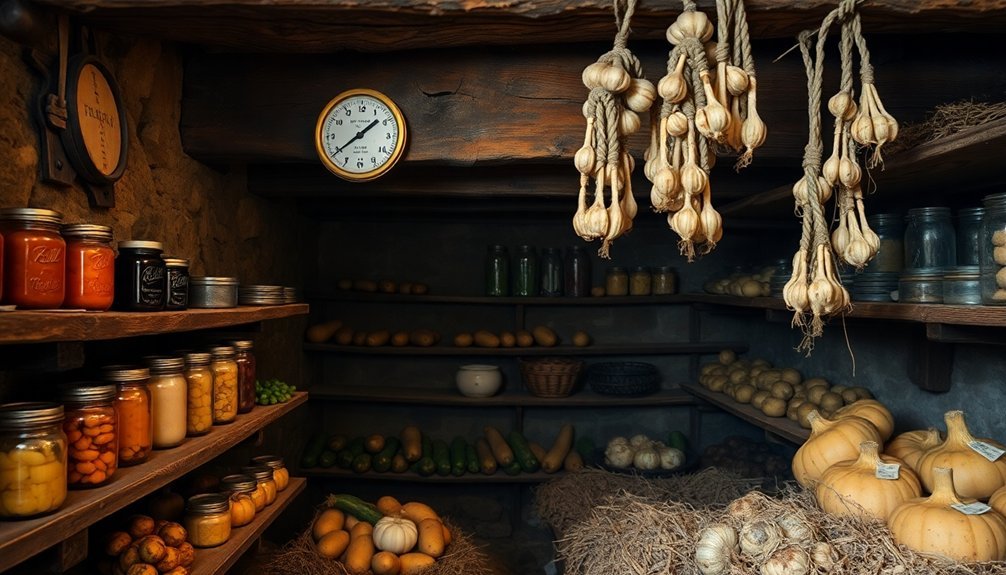
Successfully maintaining your root cellar's temperature requires different strategies throughout the year.
In winter, you'll need to take advantage of the cold weather to make ice, which you can store for summer use while keeping temperatures between 32-40°F. Make sure your cellar is dug below the frost line and properly insulated to prevent freezing.
Spring brings natural temperature changes, requiring careful ventilation management. You'll want to let stored ice melt gradually while ensuring proper air circulation to remove ethylene gas and prevent spoilage.
During summer, utilize your winter-made ice to maintain temperatures around 37°F, and focus on proper ventilation by allowing cool night air in through low intakes and warm air out through high outlets.
- Picture rows of glass jars filled with preserved vegetables, their contents glistening in the dim light
- Envision streams of cool air flowing through carefully placed vents, creating a natural circulation pattern
- Imagine blocks of crystal-clear ice slowly melting, maintaining the perfect temperature for your stored harvest
As autumn arrives, let your cellar cool naturally with the season while preparing for winter storage.
You'll need to adjust ventilation to maintain ideal temperature ranges and humidity levels between 85-95%, ensuring your harvest stays fresh throughout the year.
Frequently Asked Questions
Can I Store Homemade Wine or Canned Goods in My Root Cellar?
You can store canned goods safely in your root cellar, but it's too cold for wine storage. Your canned items will keep well at cellar temperatures, but wine needs warmer conditions between 50-55°F.
How Do I Prevent Mice and Insects From Entering My Root Cellar?
You'll need to seal all entry points with steel wool and caulk, maintain clean conditions, use natural deterrents like peppermint oil and bay leaves, and store food in airtight containers to prevent pest invasions.
Should I Remove Dirt From Vegetables Before Storing Them?
You shouldn't completely clean root vegetables before storage. Just brush off loose dirt, leaving some soil intact. However, if you're storing leafy greens or berries, you'll need to wash and dry them thoroughly.
What's the Best Lighting System to Install in a Root Cellar?
Install a motion-activated LED light with an exterior switch. You'll want energy-efficient lighting that won't generate heat or stay on unnecessarily. Consider battery-powered options as backup for power outages.
Can Multiple Families Share One Large Root Cellar Effectively?
Yes, you can effectively share a root cellar with multiple families. You'll need clear organization, shared maintenance schedules, and designated storage sections. It's cost-effective and builds community while ensuring everyone's produce stays fresh.
In Summary
Maintaining your root cellar's temperature requires consistent monitoring and adjustment. You'll need to check temperatures daily, use proper storage zones, and implement both natural and mechanical cooling methods as needed. Remember, different crops have unique temperature requirements, so you'll want to organize your cellar accordingly. With the right tools and techniques, you can keep your harvest fresh throughout the year.


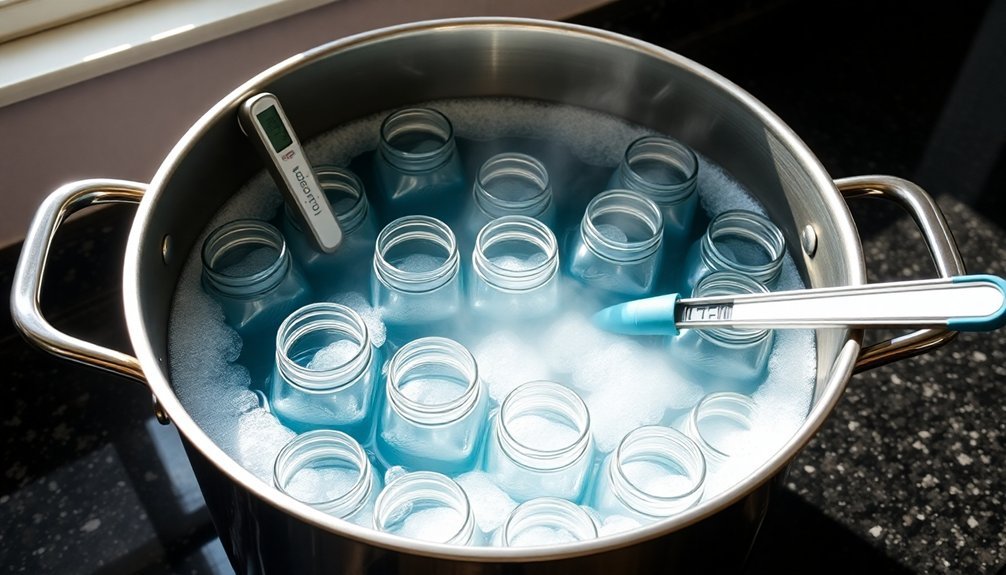
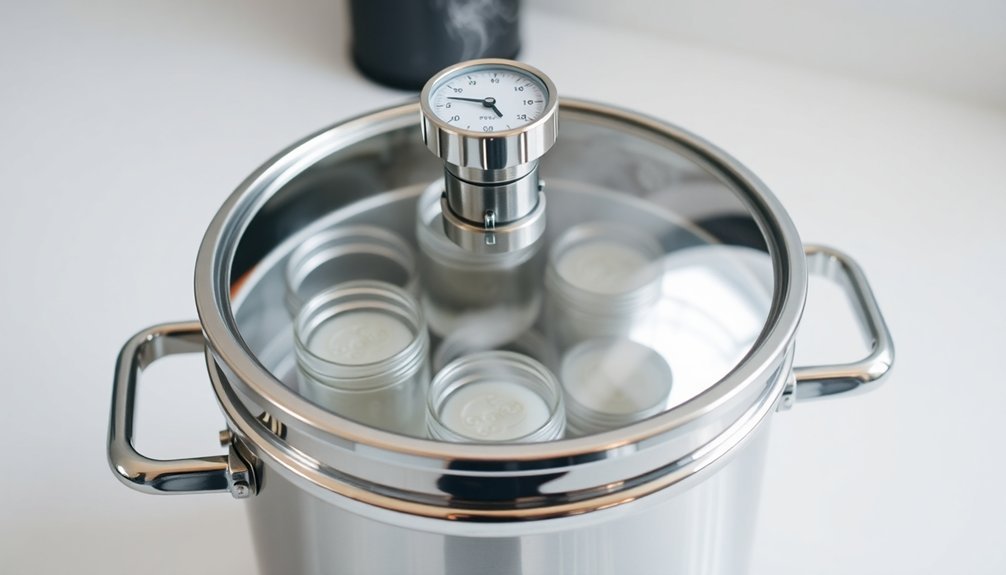
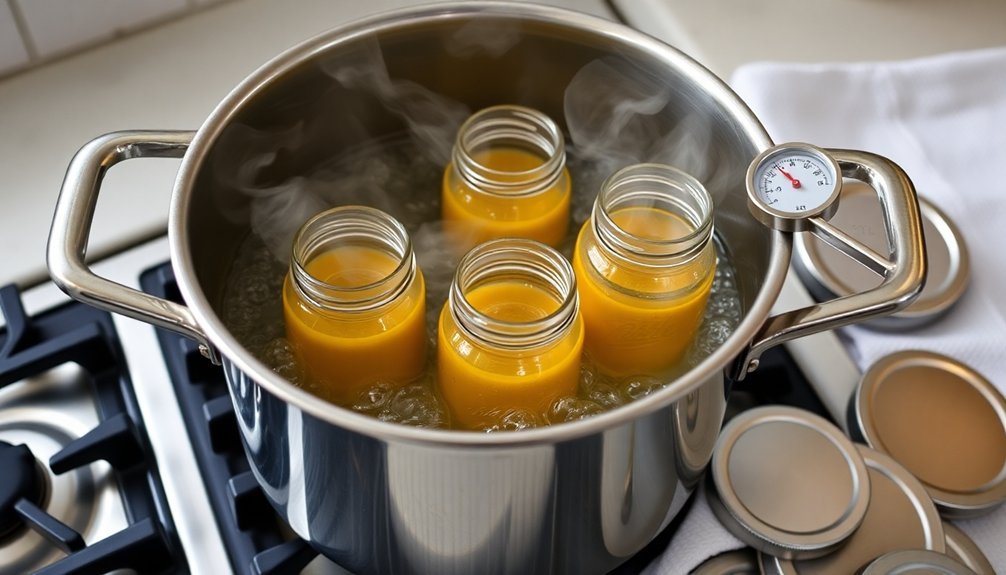
Leave a Reply